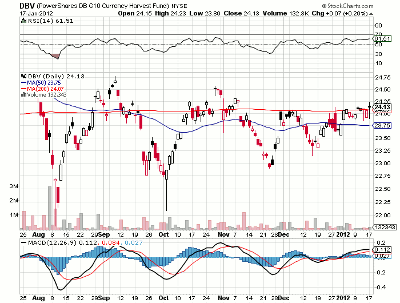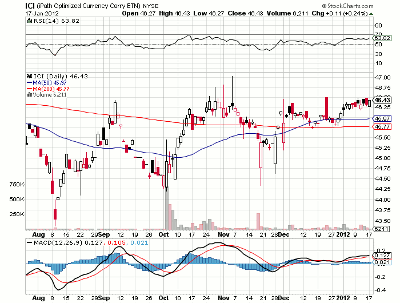The "carry trade" is a popular and potentially lucrative forex strategy, and with the advent of ETFs, traders can now implement the strategy simply by going long either of two specially designed funds.
A carry trade is a strategy by which a trader sells a certain currency with a relatively low interest rate and uses the funds to purchase a different currency yielding a higher interest rate. A trader using this strategy attempts to capture the difference between the rates, which can often be substantial, depending on the amount of leverage used.
Here’s an example of a "yen carry trade": a trader borrows 1,000 Japanese yen from a Japanese bank, converts the funds into US dollars, and buys a bond for the equivalent amount. Let’s assume that the bond pays 4.5% and the Japanese interest rate is set at 0%. The trader stands to make a profit of 4.5% as long as the exchange rate between the countries does not change.
Many professional traders use this trade because the gains can become very large when leverage is taken into consideration. If the trader in our example uses a common leverage factor of 10:1, then he/she can stand to make a profit of 45%.
The big risk in a carry trade is the uncertainty of exchange rates. Using the example above, if the US dollar were to fall in value relative to the Japanese yen, then the trader would run the risk of losing money. Also, these transactions are generally done with a lot of leverage, so a small movement in exchange rates can result in huge losses unless the position is hedged appropriately.
See related: The Forex Carry Trade Explained
Currency Arbitrage and the Carry Trade
Using a stable currency, such as the greenback, which has held a low interest rate steady for years, forms a great base for the trade. Low volatility and reliance on futures contracts combined with this stability allows for the use of leverage. Adding leverage allows better returns than the average 2%-4% interest-rate spreads between developed economies.
While currency arbitrage was once the realm of large institutional investors and pension funds, the exchange traded product boom has brought the strategy to the average Joe investor’s portfolio.
Allocating a small portion of a long-term trading portfolio to the carry trade may make sense as it is an uncorrelated asset class and can provide diversification benefits. Using exchange-traded funds makes this simple and quite affordable. There are two funds that exploit currency arbitrage.
NEXT: 2 ETFs Designed with Carry Trades in Mind
|pagebreak|The PowerShares DB G10 Currency Harvest Fund (DBV) uses leverage in its transactions to provide enhanced returns while shorting three low-interest-rate currencies and going long three higher-rate notes.
Additional return comes from a portfolio of T-bills used as collateral for the futures contracts. The fund can hold contacts in any of following ten currencies, including the greenback, euro, yen, the Australian, Canadian, and New Zealand dollars, the Norwegian krone, the Swedish krona, British pound, and the Swiss franc.
Structured as an exchange traded note (ETN), the iPath Optimized Currency Carry ETN (ICI) also tracks a long/short basket of G10 currencies.
As an ETN, the iPath fund will have reduced tracking errors, but on the downside, it will expose investors to the credit risk of the issuing firm. The fund also does not employ leverage, reducing the potential returns.
While the preceding funds make the carry trade easy, more active investors could potentially borrow dollars and invest them in any of the various single-currency funds. Popular ETFs include the CurrencyShares Euro Trust (FXE), CurrencyShares Japanese Yen Trust (FXY), and the CurrencyShares Australian Dollar Trust (FXA).
With some nations’ economies moving at slower rates than others, interest rates continue to be low. Retail investors now have the ability to participate in transactions normally reserved for larger, institutional clients. Using exchange traded funds, currency arbitrage and carry trade strategies can be implemented for any portfolio size.
By the Staff at Investopedia.com























